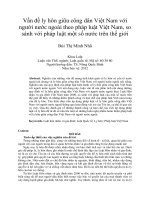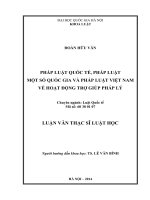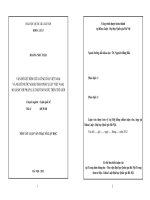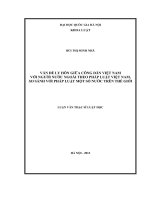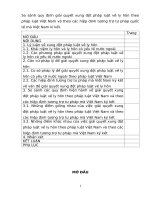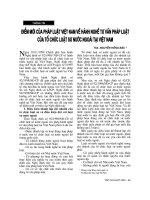Tóm tắt: Quyền sử dụng đất lâm nghiệp theo pháp luật Việt Nam từ thực tiễn các tỉnh Đông Nam Bộ
Bạn đang xem bản rút gọn của tài liệu. Xem và tải ngay bản đầy đủ của tài liệu tại đây (198.21 KB, 26 trang )
<span class="text_page_counter">Trang 1</span><div class="page_container" data-page="1">
<b>ACADEMYVIETNAM SOCIAL SCIENCES ACADEMY OF SOCIAL SCIENCES </b>
<b>NGUYEN THI THU HIEN </b>
<b>FORESTRY LAND USE RIGHTS UNDER VIETNAMESE LAW FROM PRACTICE OF SOUTHEAST PROVINCES </b>
<b>Industry: Economic law Code: 9 38 01 07 </b>
<b>DOCTOR OF LAW THESIS </b>
<b>Hanoi, 2024 </b>
</div><span class="text_page_counter">Trang 2</span><div class="page_container" data-page="2"><b>The project was completed at: Vietnam Academy of Social Sciences </b>
<b>Academy of Social Sciences </b>
<b>Scientific instructor: Associate Professor. Dr. Ha Thi Mai Hien </b>
<b>Reviewer 1: Associate Professor. Dr. Tran Dinh Hao Reviewer 2: Associate Professor. Dr. Nguyen Huu Chi Reviewer 3: Dr. Dang Vu Huan </b>
The thesis will be defended at the Academy-level Thesis Examining Council meeting at: Vietnam Academy of Social Sciences - Academy of Social Sciences, at time, minute, date, year 2023
The thesis can be found at the library: Vietnam National Library
Library of Academy of Social Sciences
</div><span class="text_page_counter">Trang 3</span><div class="page_container" data-page="3"><b>PREAMBLE 1. Urgency of the topic </b>
In Vietnam today, legal regulations on land in general and forestry land in particular are always of interest to the Party and State in promulgating guidelines and policies to promote the great effects of land. in the process of socio-economic development. The Southeast is an area with an area of: 511,319 hectares of forestry land, of which, production forest land: 172,701 hectares; Protective forest land: 158,326 hectares; Special-use forest land: 180,292 hectares. The forests here are considered the green lungs of the Southeast region. Recently, implementing guiding documents on strengthening urgent measures to protect and develop forests, forest rangers regularly patrol, inspect and coordinate with police and military agencies. Team, Market Management... organize raids on yards along the lake, illegal trading and storage of forest products; Detect and prevent many cases of illegal exploitation, trading, and transportation of forest products, of which the majority of forest products originate from neighboring provinces across the area. At the same time, promote fire prevention and fighting...
However, in the current context, current legal regulations on forestry land use rights have been revealing a series of limitations and inadequacies: there is a situation of using forestry land for improper purposes, Violations of regulations on transfer, conversion, lease, mortgage, inheritance of land use rights, legal rights of land users are not really guaranteed and still exist, which hinders The effectiveness of efforts to improve highland livelihoods, eliminate hunger and reduce poverty, increase forest coverage and quality, has a negative impact on forestry development and socio-economic life in general. In addition, the Forestry Law passed by the National Assembly in November 2017 takes effect from January 1, 2019, with the expectation of helping ethnic minorities who rely on forests enjoy many benefits. However, according to current regulations, the Forest Law has a number of problems from concept to content that are "out of phase" compared to the 2013 Land Law...
The above limitations and inadequacies are extremely urgent. If not urgently resolved, they will be a huge barrier to the development of forestry and will also be the cause of conflicts and social instability in the country. our country in the near future. Recognizing the importance of forestry in the period of industrialization and modernization of the country that the Party has set forth; The great potential and value of forestry land has not been exploited effectively due to problems and inadequacies of current legal
</div><span class="text_page_counter">Trang 4</span><div class="page_container" data-page="4">regulations; The importance and effectiveness of applying humanity's legal scientific achievements in solving the specific features of the people's ownership of land in our country, the graduate student chose the topic "Rights Forestry land use according to Vietnamese law from the practice of the Southeast provinces" as a doctoral thesis in jurisprudence.
<b>2. Objectives and research tasks of the thesis 2.1. Objectives of the study </b>
Clarifying the theoretical basis and legal practice of forestry land use rights (through practice in the Southeast provinces). From there, propose solutions to improve the law on forestry land use rights in the coming period.
<b> 2.2. Thesis research tasks </b>
To achieve the research purpose, the thesis performs the following specific tasks:
Firstly, state, analyze and clarify legal theoretical issues on forestry land use rights such as: Concept, characteristics of forestry land and forestry land use rights; Legal concepts, content structure, principles of the law on forestry land use rights and factors affecting the law on forestry land use rights...
Second, research and evaluate the current legal status and practical implementation of the law on forestry land use rights in the Southeast provinces, pointing out the advantages, limitations, and shortcomings of the law that need to be overcome. on forestry land use rights in Vietnam today.
Third, on the basis of the above theory and legal situation, the thesis identifies directions and proposes solutions to improve the current law on forestry land use rights.
<b>3. Subject and scope of research of the thesis 3.1. Research subjects of the thesis </b>
The research object of the thesis is the system of legal documents related to land use rights; Practical implementation of the law on forestry land use rights in the Southeast provinces.
<b>3.2. Research scope </b>
- Spatial scope: The thesis focuses on researching the legal status of forestry land use rights through the practice of the Southeast provinces.
- Time scope: The thesis researches legal regulations on forestry land use rights in Vietnam up to the present time and practice from 2013 to 2023;
- Scope of legal documents: The thesis researches legal regulations related to land use rights in general and forestry land use rights in particular
</div><span class="text_page_counter">Trang 5</span><div class="page_container" data-page="5">as stipulated in the Constitution, Civil Code, Land Law, Forestry Law... and other relevant legal documents.
<b>4. Methodology and research methods of the thesis 4.1. Methodology </b>
The thesis carries out research tasks on the basis of dialectical materialism and historical materialism Marxism-Leninism, theory of state and law. This is a scientific methodology applied throughout the entire thesis to objectively evaluate the actual legal system in the field of forestry land use rights and the practical implementation of land use rights laws. forestry in the Southeast provinces.
<b> 4.2. Research Methods </b>
- Analysis and interpretation method: This is the method used throughout the topic to evaluate, analyze and present legal perspectives on forestry land use rights, drawing out basic characteristics of forestry land use rights. forestry land use rights (chapter 2 and chapter 3). From there, propose solutions to improve the law on forestry land use rights.
- Historical method: Used in chapters 2 and 3 of the thesis to study the process of formation and development of the law on forestry land use rights.
- Statistical methods and practical surveys: Based on practical documents from industries and localities, the thesis analyzes and evaluates the current situation of forestry land use rights, stating results and limitations. in the Southeast provinces as a basis to compare, analyze and propose solutions.
- Synthetic method, mainly used in chapter 3 of the thesis when evaluating the current legal situation on forestry land use rights in order to draw recommendations.
In addition, the author also combines many other methods such as: System method; Scientific analysis and forecasting methods.
<b>5. New scientific contributions of the thesis </b>
The thesis is an elaborate, comprehensive and systematic study of the law on forestry land use rights from the practice of the Southeast provinces. Based on the research tasks set out, the thesis makes new scientific contributions, while also providing arguments for current law-making research in the field of forestry land use rights.
Contribute to developing and supplementing the theoretical and practical basis of forestry land use rights such as: Concept and characteristics of forestry land use rights; factors affecting the law on
</div><span class="text_page_counter">Trang 6</span><div class="page_container" data-page="6">forestry land use rights; The process of perfecting the legal regime on forestry land use in Vietnam during the period of market economic development.
Analyze the current situation and evaluate the practical application of the law on forestry land use rights in the Southeast provinces, pointing out the limitations and inadequacies of the current law and the difficulties and obstacles in Practical implementation of laws on forestry land use rights.
Based on the assessment of the current state of law enforcement, the thesis gives directions and proposes specific directions and solutions to improve the current law on forestry land use rights.
<b>6. Theoretical and practical significance of the thesis 6.1. Theoretical significance </b>
The thesis is an in-depth study of the theoretical basis and legal status of forestry land use rights through practical implementation in the Southeast provinces.
<b>6.2. Practical significance </b>
The research results of the thesis have reference value for relevant agencies in policy making, building and perfecting the law on forestry land use rights in Vietnam. Besides, the thesis can also help those working in the field of land management, forest protection and development in the process of enforcing laws on forestry land use in Vietnam in general and the Eastern provinces. The South in particular today. The thesis can be a reference source in researching and teaching land law subjects for law training institutions.
<b>7. Structure of the thesis </b>
In addition to the introduction and conclusion, the thesis includes 4 chapters:
Chapter 1: Overview of the research situation and issues related to the thesis
Chapter 2: Theoretical issues on forestry land use rights and the law on forestry land use rights
Chapter 3: Current status of law on forestry land use rights and practical implementation in the Southeast provinces
Chapter 4: Orientations and solutions to improve the law and improve the effectiveness of implementing the law on forestry land use rights in Vietnam today.
</div><span class="text_page_counter">Trang 7</span><div class="page_container" data-page="7"><b>Chapter 1 </b>
<b>OVERVIEW OF RESEARCH SITUATION </b>
<b>1.1. Research projects related to the thesis </b>
<i><b>1.1.1. Research projects related to legal theory on forestry land use rights </b></i>
Research works related to theoretical issues of forestry land use rights have focused on studying the basic characteristics of land use rights. In addition, a number of works have shown that forestry land use rights are one of the types of land that can be used as assets for capital contribution without delving into the legal aspects of the rights. forestry land use.
<i><b>1.1.2. Research projects related to the current status of forestry land use rights </b></i>
From the perspective of research related to land use rights, the authors only mention the current situation of land use rights in general in the real estate market, without going into depth about forestry land use rights, but it is meaningful in terms of The theoretical aspect helps the thesis clarify the legal regime on forestry land use in Vietnam during the period of market economic development.
<i><b>1.1.3. Research projects related to orientations and solutions to improve the law on forestry land use rights </b></i>
In terms of solutions, the majority of research projects are based on the legal situation regarding some rights of land users. At the same time, point out shortcomings and limitations and propose solutions to overcome those limitations.
<i><b>1.1.4. General assessment of the research situation </b></i>
In general, most research works on land use rights and forestry land analyze theoretical issues about land use rights, the formation and development of laws on land use rights; Legal status of some rights of land users. At the same time, point out shortcomings and limitations and propose solutions to overcome those limitations. The question is what is the current situation and practical application of the law on forestry land in the Southeast provinces? Are there any inadequacies in applying the law on forestry land? What solutions should be proposed to improve the law on forestry land use rights? These are issues that the thesis needs to continue to research in depth and clarify.
In summary, the issue of land use rights in general and forestry land use rights in particular has been received by many researchers from many different angles and aspects, which are quite profound, systematic and
</div><span class="text_page_counter">Trang 8</span><div class="page_container" data-page="8">valuable. Currently, there are many inadequacies in the practical implementation of legal regulations on forestry land use rights. However, it can be seen that there has not been any work that systematically and fully studies the contents of this issue. There has also been no research to clarify the specificities of the Southeast region as a basis for proposing appropriate policies on forestry land use rights. The Southeast is a land of cultural, religious and ethnic diversity, so policies must also be specific and appropriate to the culture of local people. Effective use of forestry land must be associated with hunger eradication, poverty reduction and improvement of people's livelihoods. On the other hand, previous scientific research works related to the actual law on forestry land use rights are no longer appropriate. However, the above research works are still valuable documents for graduate students to refer to when researching this topic.
Therefore, continuing to study the legal regulations on forestry land use rights to find out the shortcomings, problems and find out the causes of those limitations to propose additional recommendations to improve the law. Law is a necessary and urgent issue. It can be said that this is the first scientific research work that directly and systematically studies the field of law on forestry land use rights from the practice of the Southeast provinces.
<b>1.2. Research hypotheses and research questions </b>
<i><b>1.2.1. Research hypothesis </b></i>
Theoretical issues about land use rights and forestry land have been researched in majors such as: Land Law, Forestry Law, State Management of Land... However, the theory of land use rights Forestry has not been studied in depth, so there are still many issues that need to be clarified.
Access to land through land allocation, lease, and forestry land contracting by the State to land users is facing difficulties and inadequacies. These inadequacies stem from the provisions of the Land Law and Forestry Law.
The issue of perfecting the law on forestry land use rights must ensure feasibility, synchronization and consistency.
<i><b>1.2.2. Research questions </b></i>
To achieve that research purpose, PhD students will focus on answering the following specific questions:
What is the theoretical basis of forestry land use rights?
What is the current state of the law on forestry land use rights and the practical implementation of the law on forestry land use rights in the Southeast provinces?
</div><span class="text_page_counter">Trang 9</span><div class="page_container" data-page="9">What are the directions and solutions to improve the law on forestry land use rights in Vietnam and the Southeast provinces?
<b>CHAPTER 2 </b>
<b> THE ORETICAL ISSUES OF FORESTRY LAND USE RIGHTS AND LAW ON FORESTRY LAND USE RIGHTS </b>
<b>2.1. Theory of forestry land use rights </b>
<i><b>2.1.1. Concept, characteristics, role of forestry land </b></i>
<i>2.1.1.1. Concept of forestry land </i>
Up to now, the concept of forestry land according to management agencies still has many differences. However, to serve the purpose of managing and using forestry land resources effectively and sustainably, the concept of forestry land has been institutionally agreed upon by State agencies for management purposes. General principles and directions, specifically: Forestry land is land with natural forests or planted forests that meet forest standards according to the provisions of law on forest protection and development; land is being zoned for forest restoration; Newly planted land but not yet a forest; land under afforestation or allocated or leased for afforestation and vacant land areas in special-use forests[7, p.6].
Forestry land is land belonging to the agricultural land group for the purpose of producing and trading forest products or protecting soil and water resources against erosion, preventing natural disasters, and protecting
- Diversity and richness
- Associated with human activities
<i>2.1.1.3. The role of forestry land </i>
Land originates from nature, along with the rotation of the wheel of time, people appear and impact the land, improve the land and turn the land from a product of nature back to its labor power. Human action is also a product of society.
<i><b>2.1.2. Concept and characteristics of forestry land use rights </b></i>
<i>2.1.2.1. Concept of forestry land use rights </i>
From a number of definitions and assessments of scientists, through the relationship between the State and organizations, households, and
</div><span class="text_page_counter">Trang 10</span><div class="page_container" data-page="10">individuals using land, especially from the way the law deals with regulations. regulations on the rights of non-owners to property, including land use rights, and methods of protecting the property rights of non-owners are also implemented as insurance. Protection for property owners, land use rights should be defined as follows: Land use rights are property rights owned by organizations, households, and individuals arising on the basis of land allocation decisions. , land lease, recognition of land use rights by competent state agencies or from land use rights transfer transactions. The possession, use, and disposition of land use rights must comply with the conditions and procedures prescribed by law.
<i>2.1.2.2. Characteristics of forestry land use rights </i>
First, forestry land ownership and forestry land use rights are separate. The state in the political system is the representative most qualified to be the owner. All people have the right to own forestry land and transfer that ownership to the representative of the state; The State will represent and transfer forestry land use rights to individuals, households, economic organizations... However, in reality, forestry land use rights are only transferred directly from the government. water to users through administrative decisions issued by the State.
Second, the state issues administrative decisions on allocation of forestry land use rights to forestry land users according to the order and provisions of the law. At the same time, they also have the right to issue administrative decisions to revoke forestry land use rights when necessary for public purposes, national interests, national security and defense... according to regulations, along with Compensate and support legal rights and interests for people who were assigned forestry land use rights but had their forest land revoked.
Third, the state assigns forestry land use rights to individuals, households, economic organizations... and for forestry land use rights to be recognized, the land user must pay a prepayment fee. land use and other fees and charges as prescribed.
Fourth, once land users have their forestry land use rights recognized by the State, land users are increasingly granted a number of rights to carry out land-related transactions, such as the right to freely You transfer forestry land use rights but must strictly comply with the procedures as prescribed by land law. Because, as we analyze, land use rights are a special asset and commodity and have their own regulations unlike the exploitation and use of other assets in normal civil transactions.
<b>2.2. Legal theory on forestry land use rights </b>
</div><span class="text_page_counter">Trang 11</span><div class="page_container" data-page="11"><i><b>2.2.1. Legal concept of forestry land use rights </b></i>
The law on forestry land use rights is a collection of legal norms that regulate social relationships arising in the process of establishing and implementing
implementation, ending the rights to forestry land and the obligations to the state of forestry land users.
In terms of form, the law on forestry land use rights is currently contained in many different legal documents such as the 2013 Constitution, the 2015 Civil Code, the 2017 Law on Forestry... but mainly The most important is still the provisions in the Land Law 2013. In addition, legal documents under the law such as decrees and circulars also contain legal regulations of this institution.
<i><b>2.2.2. Principles of law on forestry land use rights </b></i>
Constitutional principle of universal ownership of land.
The Constitution of the Socialist Republic of Vietnam affirms: “Land, mineral resources, resources in the sea, airspace, and other natural resources... belong to the entire people and are represented by the State. representative ownership and unified management. (Article 53 of the Constitution). In order to concretize the Constitution, the Land Law stipulates: The State grants land use rights to land users according to land laws. Thus, the State is not the owner but only the owner's representative to manage land and other assets owned by the entire people; Organizations, households and individuals are those who are allocated land for use by the State according to the Constitution and law.
Principles of sustainable development
Based on the principle of sustainable development, legal regulations on forestry land use rights are promulgated and enforced with contents such as: Protecting and developing forestry land to contribute to environmental protection. environment, responding to global climate change; create conditions and instructions for subjects to replenish and improve forestry land and avoid exploitation to the point of exhaustion; Prioritize vulnerable subjects in society to access and use forestry land...
Principle of stimulating economic benefits
Currently, influencing economic interests is a highly effective measure in adjusting the behavior of subjects according to the wishes of the State. Accordingly, if there are economic benefits, the subjects will actively and proactively implement fully the goals desired by the State. At the same time, to avoid loss of economic benefits, subjects will be responsible for
</div><span class="text_page_counter">Trang 12</span><div class="page_container" data-page="12">fully fulfilling their legal obligations to avoid being subject to sanctions such as fines, land confiscation, etc.
<i><b>2.2.3. Structure of the content of the law on forestry land use rights </b></i>
The structure of legal content on forestry land use rights includes the following groups of legal regulations:
Group of legal regulations on determining types of forest land (forest land) and corresponding subjects of rights to use forest land types (forest land)
Group of legal provisions on legal methods of forming, confirming and terminating forestry land use rights
Group of legal provisions on the rights and obligations of subjects with rights to use forestry land
Group of legal regulations on resolving disputes over forestry land use rights; on handling violations of forestry land use rights
<b>2.3. Factors affecting the law and implementation of the law on forestry land use rights </b>
<i><b>2.3.1. Land policy and law factors </b></i>
Forestry land use rights are governed by the Party's viewpoints and policies on building and perfecting land laws and developing agriculture, rural areas and farmers in the current period.
<i><b>2.3.2. The regime of universal ownership of land </b></i>
Forestry land use rights are derivative and depend on the people's ownership of land. All regulations on the object, subject and content of forestry land use rights are determined by the State. as the representative of the entire people's ownership, issue it and ensure its implementation in practice. At the same time, all regulations on the object, subject and content of forestry land use rights are also to implement the people's right to ownership of land in practice. Therefore, the regulation of forestry land use rights is influenced by the regime of universal ownership of land.
<i><b>2.3.3. Qualifications, capacity, political qualities and ethics of the team of officials and civil servants performing state land management tasks </b></i>
The political and ethical qualities of officials and civil servants in charge of state management of land have a direct impact on the implementation of the law on forestry land use rights. They must know how to combine the Party's viewpoints and guidelines, the laws and policies of the State with the socio-economic conditions and practical conditions of the country and each locality to implement the law on solving problems. issues of forestry land use rights. To ensure effective implementation of the law on
</div><span class="text_page_counter">Trang 13</span><div class="page_container" data-page="13">forestry land use rights, it is necessary to improve legal knowledge, professional qualifications, capacity, and professional skills, in addition to strengthening education and training. Cultivate political qualities, ethics, and lifestyle for cadres and civil servants responsible for state management of land.
<i><b>2.3.4. Cultural factors, customary laws, and legal consciousness </b></i>
The customary land tenure system can be understood as access, control and use of land and is determined through long-term applied principles, operating outside the official system of the State, or legal. These principles relate to traditional land management institutions and customary law that determine how rights are governed, allocated and protected. In this respect, there are still inadequacies and conflicts between laws, policies and customary land tenure rights in mountainous areas.
<i><b>2.3.5. Guarantees regarding capital and facilities </b></i>
Implementing the law requires certain costs. Especially in the field of forestry land use. Reality has proven that doing anything without funding and facilities is difficult to do. This is especially true in the field of resolving disputes over forestry land use rights. Currently, the majority of investment funding in the field of implementing the law on forestry land use rights is based on the state budget. However, in the context of tight and limited state budgets, the effectiveness of law enforcement on forestry land use rights has not achieved the desired effect. To overcome this limitation, the State needs to have a mechanism to create additional channels to supplement funding sources for the forestry sector.
<i><b>2.3.6. Factors of assistance and international integration </b></i>
International aid has contributed to creating achievements in afforestation, creating jobs in forestry, protecting and preserving forests, developing forest industry and transitioning to a social forestry. Although aid from international donors to Vietnam's forestry sector is still quite high (18% of total forestry investment in 2005), recent trends show that aid is gradually decreasing[43, p. 32]. Foreign aid will gradually decrease as Vietnam joins the group of middle-income countries and may have major effects such as: Reducing investment budgets in forestry activities, gradually cutting support build capacity, move away from technical advice from international projects and reduce donor influence in forest governance. Land use rights in general and land use rights in particular were born in association with the establishment and maintenance of property rights on land in our country. Land use rights are a legal creation and a legal tool to implement land use rights. Forestry land is land belonging to the
</div>